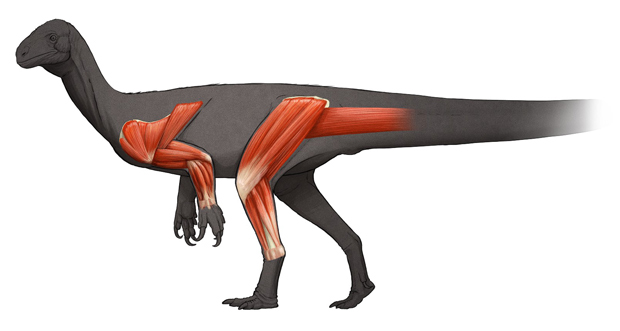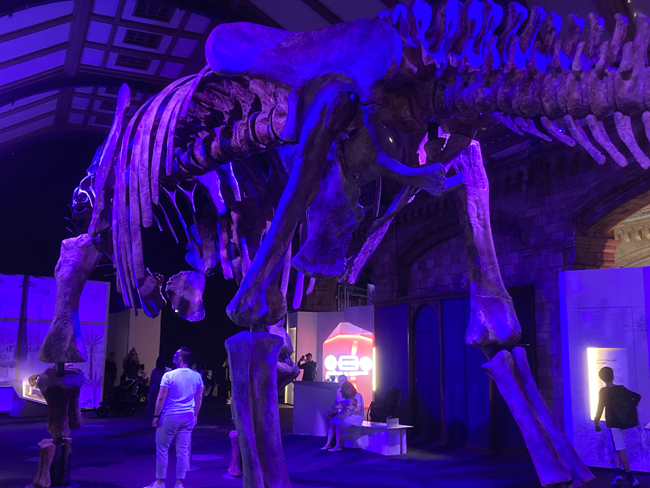New research into the musculature of the early sauropodomorph Thecodontosaurus antiquus has helped scientists to understand the evolutionary transition from agile bipeds to super-sized quadrupedal sauropods. Writing in the open-access, on-line journal “Royal Society Open Science”, scientists from the University of Bristol have reconstructed the limb musculature of Thecodontosaurus. Their reconstruction shows that this Late Triassic dinosaur was an agile, biped but it already had some anatomical adaptations which would permit its descendants to grow to huge sizes.

Thecodontosaurus fossil block with life reconstruction in the background. Picture credit: Simon Powell/University of Bristol.
Picture credit: Simon Powell/University of Bristol
Bristol’s Dinosaur
Thecodontosaurus (T. antiquus) fossils are known from Upper Triassic rocks exposed around the city of Bristol in England. During the Late Triassic, this region consisted of an archipelago surrounded by a warm tropical sea. Hundreds of fragmentary fossils representing many individuals are known, most of these fossils are housed at the Bristol City Museum and Art Gallery. Thecodontosaurus is believed to have measured up to 2.5 metres in length, however, its long, thin tail made up more than 50% of its entire body length.
It weighed around twenty kilograms, but it was part of the Sauropodomorpha clade of lizard-hipped dinosaurs that were to evolve into giants during the Jurassic and Cretaceous. Famous dinosaurs such as Diplodocus and Brachiosaurus from the Jurassic as well as Cretaceous leviathans such as Patagotitan and Alamosaurus.
Thecodontosaurus
Thecodontosaurus was the first Triassic genus of dinosaur to be named and described (1836).

Researchers have examined tell-tale muscle scars associated with Thecodontosaurus limb bones to reconstruct the musculature of this Late Triassic dinosaur. Picture credit: Gabriel Ugueto.
Picture credit: Gabriel Ugueto
Lead author of the paper, PhD student at the University of Bristol Antonio Ballell commented:
“The University of Bristol houses a huge collection of beautifully preserved Thecodontosaurus fossils that were discovered around Bristol. The amazing thing about these fossilised bones is that many preserve the scars and rugosities that the limb musculature left on them with its attachment.”
These features on the bones permit palaeontologists to infer the shape, size and anatomical position of the musculature of the animal. For example, the muscles associated with the limbs can be reconstructed and the dinosaur’s anatomy can be further refined by comparing the computer models generated with the anatomy of extant relatives such as crocodiles and birds.
Co-author of the study Professor Emily Rayfield (University of Bristol), added:
“These kinds of muscular reconstructions are fundamental to understand functional aspects of the life of extinct organisms. We can use this information to simulate how these animals walked and ran with computational tools.”
Palaeontologists Continuing to Learn from Thecodontosaurus Fossils
Thecodontosaurus was one of the first dinosaurs to be formally named and described but palaeontologists can still learn a lot from its fossils. For example, thanks to the considerable volume of T. antiquus material, the research team were able to build the entire forelimb and hindlimb musculature. This is the first time scientists have been able to reconstruct the limb musculature of an early-branching sauropodomorph.
The analysis of the limb muscles of T. antiquus confirm that it was a fast-running, agile biped. The forelimbs were probably not used in locomotion but were very effective at grasping objects such as potential prey. The anatomy of the lithe Thecodontosaurus is in stark contrast to the later sauropods which became obligate quadrupeds.
The researchers determined that key traits of later sauropod-line dinosaurs had already evolved in this early genus.
“From an evolutionary perspective, our study adds more pieces to the puzzle of how the locomotion and posture changed during the evolution of dinosaurs and in the line to the giant sauropods. How were limb muscles modified in the evolution of multi-ton quadrupeds from tiny bipeds? Reconstructing the limb muscles of Thecodontosaurus gives us new information of the early stages of that important evolutionary transition.”
Picture credit: Everything Dinosaur
Everything Dinosaur acknowledges the assistance of a media release from the University of Bristol in the compilation of this article.
The scientific paper: “Walking with early dinosaurs: appendicular myology of the Late Triassic sauropodomorph Thecodontosaurus antiquus” by Antonio Ballell, Emily J. Rayfield and Michael J. Benton published in Royal Society Open Science.
Visit the Everything Dinosaur website: Everything Dinosaur.







Leave A Comment